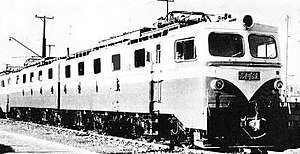Red Flag 6-class locomotive
The Red Flag 6-class (Korean: 붉은기6 Pulg'ŭn'gi-6) is a 4,200 kW (5,600 hp)[1] two-section, permanently coupled electric locomotive built by the Kim Chong-t'ae Electric Locomotive Works and used by the Korean State Railway for heavy freight trains on mountainous lines.[2]
| Red Flag 6 | |||||||||||||||||||
|---|---|---|---|---|---|---|---|---|---|---|---|---|---|---|---|---|---|---|---|
 The first prototype of the Red Flag 6 class at its rollout in 1981. | |||||||||||||||||||
| |||||||||||||||||||
| |||||||||||||||||||
| |||||||||||||||||||
| |||||||||||||||||||
Description
As the electrification of the Korean State Railway's network continued into the 1980s, the Red Flag 1 and Red Flag 2 class locomotives were the dominant type in service under the wires. However, with the electrification of steep mountain lines, it was realised that a more powerful locomotive was needed. Therefore, the Kim Chong-tae Electric Locomotive Works began design work on an articulated locomotive to operate freight trains on the difficult mountainous sections.[2]
Using the Red Flag 2 class as a starting point, the Red Flag 6 (붉은기6, Pulg'ŭn'gi-6) class was developed.[2] The result was a permanently coupled Bo'Bo'+Bo'Bo' articulated locomotive with eight capacitors,[3] made up of two sections; these sections are single-cab versions of the Red Flag 2. The Red Flag 6 class is thus an articulated descendant of the Škoda Type 30E, which had formed the basis for the design of the Red Flag 1 and Red Flag 2 after North Korea bought a licence to build the type, including technology transfer, from Czechoslovakia.[2] The first prototype was shown in 1981.[4]
Numbered in the 6000 series, production of the new design began in 1986, and was put into service in 1987 to haul freight trains on the P'yŏngra Line.[5] These four-bogie, eight-axle articulated units are 33 metres (108 ft 3 in) long, weigh 176 tonnes (388,000 lb) and produce 4,240 kilowatts (5,690 hp). They have a maximum speed of 100 kilometres per hour (62 mph) and can pull 3,200 tonnes (7,100,000 lb).[6] Trial runs with passenger trains were undertaken, but the type is now mainly used on east-west freight trains on the P'yŏngra Line.[2] The first prototype received a cream over red paint scheme, but production units are painted in the standard light blue over dark green livery.
References
- http://www.cchere.com/topic/3893100
- Kokubu, Hayato, 将軍様の鉄道 (Shōgun-sama no Tetsudō), ISBN 978-4-10-303731-6
- "통일무지개 뉴스 - 중앙일보". Nk.joins.com. 2020-04-23. Retrieved 2020-05-09.
- "デロイを探せ!(その34) 1965年以降の朝鮮画報にデロイ発見出来ず 前篇 | ゴンブロ!(ゴンの徒然日記)". Ameblo.jp. Retrieved 2020-05-09.
- "デロイを探せ!(その20) 北朝鮮のデロイ資料1 | ゴンブロ!(ゴンの徒然日記)". Ameblo.jp. Retrieved 2020-05-09.
- http://www.cchere.com/article/3895102